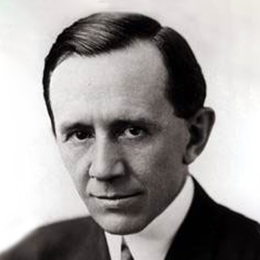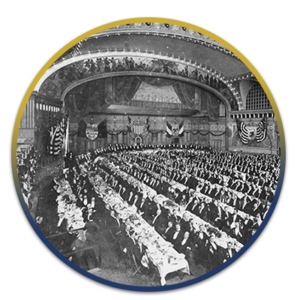Needless to say, I found Chicago surcharged with Hoosier exiles…you can’t get away from a Hoosier no matter where you go…the winds of Heaven never favored the border of a better land than our Indiana.George Ade, Charter Member, 1905
The mission of the Indiana Society of Chicago Foundation is…
HOOSIERS IN THE BIG CITY
The Story of the Indiana Society of Chicago Foundation
America was winding down a century of maturation in an optimistic advance to the next one. And rural America was increasingly wending its way into urban centers, each influencing the other. Ingredients were cohering that would give rise to a uniquely flavored concoction which would be called the Indiana Society of Chicago. And Hoosier George Ade (perhaps so destined) was to be the first among co-concoctors.

There had been failed attempts by others in 1901 to bring together the Hoosier natives in the Windy City through the “Indiana Club of Chicago.” But it would take three Indiana expatriates with extraordinary complementary talents and a common bond to form the Indiana Society of Chicago.
1901
Indiana Society of Chicago Founded
In 1905, native Hoosiers George Ade, John T. McCutcheon and Edward M. Holloway came to Chicago to seek their fortunes. On September 22, 1905, they founded the Indiana Society of Chicago along with 44 other Hoosiers as charter members, with the goal of celebrating the uniqueness of being a Hoosier – whether native or adopted – to promote understanding of Indiana’s rich history and its significant place in the history of the United States.
September 22, 1905
Golden Age of Indiana Literature
At the time of the Society’s creation, Indiana was the toast of the literary world, second only to New York in the number of published authors. This Golden Age of Indiana Literature would naturally influence the Society’s early membership composition and character of its celebratory dinners.
Besides Ade, McCutcheon and Nesbitt, other literary luminaries associated with the Society included James Whitcomb Riley, Booth Tarkington, Meredith Nicholson, Kin Hubbard and George Barr McCutcheon. James Whitcomb Riley, as Hoosier a poet as ever was, summed up the Society’s charter members as “you who have the fortune of birth and the misfortune of migration.”
The First Dinner
The inaugural Dinner celebration took place on December 21, 1905, at the elegant Auditorium Hotel on Michigan Avenue where 375 tuxedo-clad men in attendance were served a menu of Blue Point, Whitefish au Chablis, Tenderloin of Beef Bordelaise, Roast Philadelphia Squab, Cream of Spinach Solferino, Sorbet au Kirsch, Meringue Glace and more.
The playfully irreverent intention of the Society was forever ingrained at the first dinner by Ade in his opening remarks, “. . .I came to Chicago, but I couldn’t get away from Hoosiers. In fact, you can’t get away from a Hoosier no matter where you go. Needless to say, I found Chicago surcharged with Hoosier exiles – men who were here not because they wanted to leave Indiana, but because the population up here could be worked more easily than the bright native article down home.”
Among the headliners at the first dinner were, in addition to Ade, McCutcheon and Holloway, fellow Board of Trustee member, Senator Albert T. Beveridge, Federal Judge and later Baseball Commissioner Kenesaw Mountain Landis and the Presidents of Purdue and Notre Dame Universities.
December 21, 1905
Beginning in 1950, the Society has honored an Indiana Company at the Society’s Annual Dinner. Honorees have included Eli Lilly & Company, United Air Lines, NIPSCO, Ball Corporation, Marsh Foods, Cummins-Allison Corporation, the Indianapolis Motor Speedway and Vectren.
1950
The Society began honoring a different Indiana Educational institution in 1968. Recent Honorees have included Valparaiso University, Purdue University, Vincennes University, the University of Notre Dame, Indiana State University and Indiana University.
1968
Reaffirming the Mission
In the summer of 1995, Society’s Board of Directors met for an introspective planning retreat – and made a reality check. The result was a strong reaffirmation of purpose and setting of some new goals and resolutions:
- Clarify and communicate its purpose and philosophies by reassessing the Society’s role in a changing world in its mission statement
- Underscore its support of education by providing scholarships to Indiana students through an education foundation
- Develop more awareness of the Society’s purpose and value by building alliances with Indiana organizations and cultivating media relations
1995
Honoring Hoosier People & Places
In 1995, the Indiana Society of Chicago collectively honored the City of Vincennes, Vincennes University and six local firms with deep community ties. The celebration of Hoosier places and people continue today with past honorees including the Indianapolis Museum of Art, James Whitcomb Riley Society, Indiana Historical Society and the State of Indiana itself.
In 1997, the Society responded to a critical need for financial assistance to deserving students and formed a foundation to provide scholarships to greater Chicago area men and women attending colleges and universities in the State of Indiana. An Indiana Society of Chicago Scholarship has since been awarded at each Annual Dinner to students in their junior year from that year’s honored educational institution. The response from the membership has been enormous — the generous contributions have allowed the Society to award multiple scholarships within a given year.
1997
Over the last 113 years, the Society has continuously grown in membership to include leaders in the great state of Indiana – political, educational and business – who are some of the most prestigious and successful men and women in Indiana, including college and university presidents, former governors, U.S. Senators, chairmen and CEOs of major corporations as well as mayors from all over the state.
Today
Founders
 George Ade was a wide-eyed boy of five near Kentland, Indiana in 1871 when the city of Chicago, in extraordinary fashion, cast out its lure to him. “That one night in October, just as far back as I can reach in the past, we sat on the fence and looked at a blur of illumination in the northern sky and learned that the city, which we had not seen, was burning up in a highly successful fashion.”
George Ade was a wide-eyed boy of five near Kentland, Indiana in 1871 when the city of Chicago, in extraordinary fashion, cast out its lure to him. “That one night in October, just as far back as I can reach in the past, we sat on the fence and looked at a blur of illumination in the northern sky and learned that the city, which we had not seen, was burning up in a highly successful fashion.”
Ade began at the customary bottom in 1890 as a weather reporter for a major Chicago newspaper. He shared a room in a seedy rooming house with his Purdue University Sigma Chi fraternity brother, John T. McCutcheon, who was something of a writer himself, but more of an artist. Ade’s journalistic skills were apparent early on, and he was given the plum assignment of covering Chicago’s colossal coming of age party for the world, the Colombian Exposition of 1893. After the success of his descriptive pieces entitled “All Roads Lead to the Fair,” with pen and ink illustrations by John T. McCutcheon, he was given a permanent column and became one of Chicago’s first roving reporters, free to cover anything he wished. “Stories of the Street and of the Town,” once again illustrated by McCutcheon, was masterful, as was his book, “Fables in Slang” published in 1897.
He tried his hand at writing for the stage with resounding results: three smash hits, The County Chairman, The Sho-Gun and his most popular and successful work, The College Widow, ran simultaneously on Broadway in 1905. Now wealthy, he purchased a farm near Brook, Indiana, built his estate home, Hazelden, and hosted visits by Theodore Roosevelt, William Howard Taft, Will Rogers, Douglas MacArthur, Tom Mix, Gene Tunney and other celebrities.
The esteemed critic, H.L. Mencken said, his writing was “as thoroughly American in cut and color, in tang and savor, in structure and point of view as the works of Will Dean Howell. . .or Mark Twain.” His name and estate established, he was freed up and of a mind to start a Society.
 The name of his friend, John T. McCutcheon, to some generations is synonymous with his famous “Injun Summer” drawing and text, evoking boyhood memories of curling smoke from bonfires in Hoosier corn fields. It first appeared in the Chicago Tribune in 1912 and continues today, each autumn. As featured cartoonist, McCutcheon was the first Tribune staff member to win a Pulitzer Prize. His artistry would prove to be invaluable to the Indiana Society of Chicago.
The name of his friend, John T. McCutcheon, to some generations is synonymous with his famous “Injun Summer” drawing and text, evoking boyhood memories of curling smoke from bonfires in Hoosier corn fields. It first appeared in the Chicago Tribune in 1912 and continues today, each autumn. As featured cartoonist, McCutcheon was the first Tribune staff member to win a Pulitzer Prize. His artistry would prove to be invaluable to the Indiana Society of Chicago.





